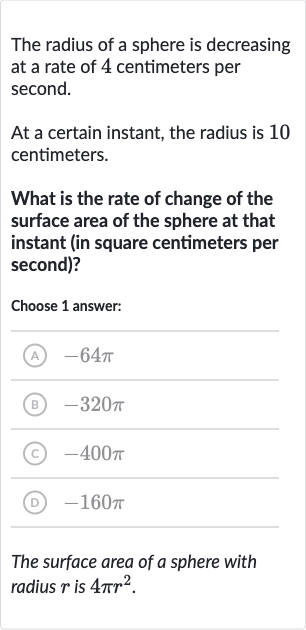AI tutor
Welcome to Bytelearn!
Let’s check out your problem:

The radius of a sphere is decreasing at a rate of centimeters per second.At a certain instant, the radius is centimeters.What is the rate of change of the surface area of the sphere at that instant (in square centimeters per second)?Choose answer:(A) (B) (C) (D) The surface area of a sphere with radius is .
Full solution
Q. The radius of a sphere is decreasing at a rate of centimeters per second.At a certain instant, the radius is centimeters.What is the rate of change of the surface area of the sphere at that instant (in square centimeters per second)?Choose answer:(A) (B) (C) (D) The surface area of a sphere with radius is .
- Formula Explanation: The formula for the surface area of a sphere is . We need to find the rate of change of the surface area, which is .
- Rate of Change: Given that the radius is decreasing at a rate of cm/s, we'll use the chain rule to find : .
- Chain Rule Application: First, find by differentiating with respect to : .
- Differentiation with Respect to r: Now, plug in the values of cm and cm/s into the equation .
- Calculation of : Calculate : square centimeters per second.
More problems from Solve quadratic equations: word problems
QuestionGet tutor help
